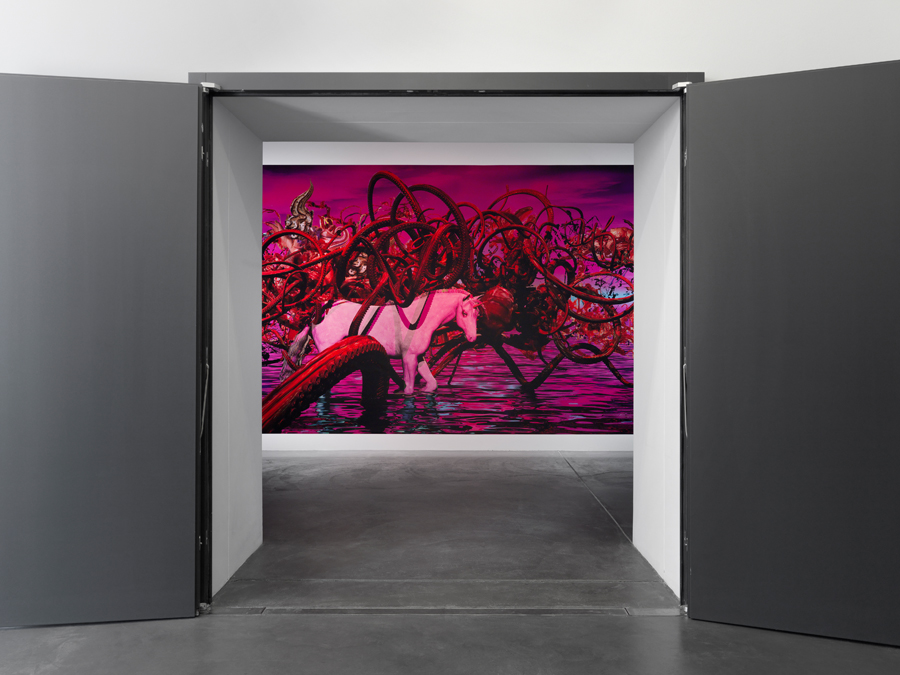John Russell
Kunsthalle Zürich, Switzerland
Kunsthalle Zürich, Switzerland

‘DOGGO’, erstwhile BANK-collective co-founder John Russell’s first institutional exhibition outside of the UK, is a spectacular experience. Take Ocean Pose [Pink] (2008), one of six huge, back-lit, digital prints on vinyl, which features a unicorn wading across a violet-pink sunset beneath a tangled cloud of red tentacles, from which protrudes ice cream and pieces of offal. Around a corner, three massive images (the longest in the show is 17 metres) surround the viewer, allowing them to fully immerse in this dazzlingly staged presentation. One of these prints is Judgement. The Kangaroo Is Not Happy. It’s Not Clear Who or What It Represents but It’s Not in a Good Place (2014). On a desert plain is a kangaroo, crying as it gazes across bloody, spiralling, viscous liquid at another (pink) marsupial.

In these ‘paintings’, as the Kunsthalle calls them, Russell’s subjects could be a shorthand for innocence (unicorns, joeys, turtles) or for abjection and decay (flies, slime, skeletons), presented with a pornographic aesthetic (glossy, smooth, slightly moist). Between these is a grove of black sculptures of simple subjects like flies and a cartoonish hand, in wood, resin, metal and other materials, each raised high on its own wobbly pole – literally and metaphorically elevated by the presentation. A bit more roughage is provided by several bill-posted prints on paper: Bertie (2016) sees a figure made of liquorice allsorts stride forward over the text ‘BERTIE BASSETT SAYS DEATH IS COMING’; Foxhunt (2017) is a photograph of portly, red-jacketed hunters embodying old power and privilege as they ride to hounds.
Colour turned up to 11 doesn’t always entail high production values – it is equally typical of sci-fi and other pulp fantasy fiction illustrations, of which Russell is a fan. In his fourth volume of writings, published as the exhibition’s catalogue, essays tumble along helter-skelter, as is suggested by the title of one: ‘Bruce Willis, Irigaray and the Aesthetics of Space Travel’ (2014). Timeframes similarly collide in Doggo (2017), a 50-minute film at the centre of the exhibition, which takes place centuries in the future but is shot in a wilfully amateurish style on the outskirts of Heathrow Airport and inside Reading School of Art, where Russell teaches. The film follows two detectives – one with a dog’s head, the other with an insect’s – as they attempt to track down someone who has gone missing from an ‘Age Centre’ retirement home, and ultimately foil an act of terrorism. In their new world, comrade creatures of hybrid sexes and species hail each other with greetings like ‘crisp and joyous’ and laugh to evade tricky personal subjects.

Broadly speaking, evasion lies at the heart of ‘Doggo’; inconsistency is the only rule. The exhibition is a smorgasbord of the digestible and indigestible, cut with lashings of irony that obscure Russell’s intent. His banner pictures are highly crafted orgies of excessive, spewing detail, yet interspersed with low-tech digs at consumerism and dehumanizing technologies. Despite this, ‘Doggo’ is eminently consumable: re-rendered and some re-cropped for the exhibition, the large-scale digital feats beg to be Instagrammed. Even though the setting is institutional, Russell’s back-lit format mimics a language adopted in the commercial worlds of advertising and sales. Accordingly, the dominant banners are complemented by smaller prints on which the artist has drawn and set gold leaf grace notes, for any potential buyers who might have a penchant for the handmade. It begs the question of who the spectators are for this spectacle, in which Russell liberally pastes and recycles images stripped of context – as with the ‘doggo’ memes that the show is named after, which ricochet around online, their meaning changing daily. I suspect Russell’s real product is the empty feeling that sticks with visitors once they have departed.
Aoife Rosenmeyer is a critic and translator based in Zurich.
Main image: John Russell, 'DOGGO', 2017, installation view, Kunsthalle Zürich. Courtesy: Kunsthalle Zürich; photograph: © Annik Wetter























